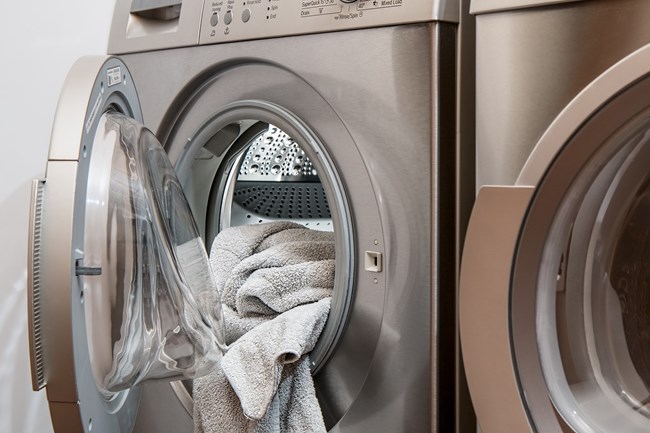Last updated: August 11, 2021
Article
Laundry Practices and Water Conservation

Laundry, a regular and mundane chore, has a significant environmental impact. With the technological advances of modern appliances and the introduction of environmentally friendly scent-free products over the past decade, it is easier than ever to "green" your laundry practices. Here are some facts about laundry:
- The average residential washing machine uses about 41 gallons of water per load.
- A clothes dryer is responsible for approximately 6 percent of the average home’s energy use.
- Commercial washing machines vary widely, using an average of 34.74 thousand gallons of water and up to 910 kWh of electricity per year.
- Scented liquid laundry detergent and dryer sheets contain hazardous chemicals and emit volatile organic compounds (VOCs), two of which are classified as carcinogens by the Environmental Protection Agency.
When you consider that the average American family washes about 300 loads of laundry per year, the environmental impacts from water use, energy use and hazardous chemicals really add up. In addition, the financial costs of energy and water from doing laundry also add up. Appliance and equipment efficiency standards established by the U.S. Department of Energy (DOE) in recent decades have led to dramatic gains in energy efficiency and saved consumers energy and money.
- New clothes washers use 70% less energy today than they did in 1973.
- ENERGY STAR certified clothes washers use about 25% less energy and 40% less water than regular clothes washers
- ENERGY STAR clothes dryers use 20% less energy than conventional models, saving an average of more than $70 per household annually.
DOE states that “if every clothes washer purchased in the U.S. was ENERGY STAR certified we could save more than $4 billion each year and prevent more than 19 billion pounds of annual greenhouse gas emissions, equal to the emissions from 1.8 million vehicles."
Commercial Laundry
The commercial laundry sector in particular has the potential to "yield significant savings" by transitioning to ENERGY STAR commercial washers since market penetration of ENERGY STAR washers is estimated at only 32%. A 2013 report by the American Council for an Energy-Efficient Economy and the Natural Resources Defense Council Water suggests that upgrades of commercial washing machines can result in savings of 9.3 to 29.6 gallons of water and reductions in dryer use can save 25,000 to 38,000 BTUs per wash cycle.
Commercial laundry products-typically made from a combination of chemicals that may include surfactants, bleaching agents, and enzymes-are intended to remove dirt from textiles and fragrance to add a "clean" scent. Dryer sheets are infused with strong fragrances. While some chemicals common in laundry products are known skin irritants, the extent of the environmental and health impacts from laundry detergent and dryer sheets is not fully understood. Complicating matters further, manufacturers are not required to disclose their ingredients. A 2011 study found that scented laundry products emit VOCs including the carcinogens acetaldehyde and benzene. Unscented environmentally friendly laundry products are safer alternatives to traditional laundry products.
Smart Energy and Water-Saving Laundry Tips from the ACEEE and Energy.gov:
- Upgrade old washing machines and dryers to ENERGY STAR certified models
- Retrofit laundromats with multi-load units.
- Wash clothes in cold water using cold-water detergents whenever possible.
- Wash and dry full loads. If you are washing a small load, use the appropriate water-level setting.
- Dry towels and heavier cottons in a separate load from lighter-weight clothes.
- Don't over-dry clothes. If a machine has a moisture sensor, use it.
- Clean the lint screen in the dryers after every load to improve air circulation and prevent fire hazards.
- Periodically, remove the lint that collects below the lint screen in the lint screen slot of clothes dryers.
- Use the cool-down cycle to allow the clothes to finish drying with the heat remaining in the dryer.
- Periodically inspect dryer vents to ensure they are not blocked. This will save energy and may prevent a fire. Manufacturers recommend using rigid venting material -- not plastic vents that may collapse and cause blockages.
- Encourage air-drying clothes on clotheslines or drying racks. Clothing manufacturers for some fabrics recommend air-drying.
- If you have front-loading washers or high-efficiency top-loaders, use detergent labeled for high-efficiency (HE) machines. According to the American Cleaning Institute (PDF), HE detergents are low-sudsing and quick dispersing to clean well in high-efficiency washers that use less water.
Smart Laundry Products Tips from EPA’s Laundry Green Practices:
- Wash only full loads of laundry, and select the appropriate water level or load size option on the washing machine and dryer.
- Buy items, such as laundry detergent and fabric softener, with minimal packaging.
- Buy items in bulk or in concentrated form (e.g., concentrated laundry detergent).
Finally, choose top-rated laundry products from the Environmental Working Group’s Guide to Healthy Cleaning.
